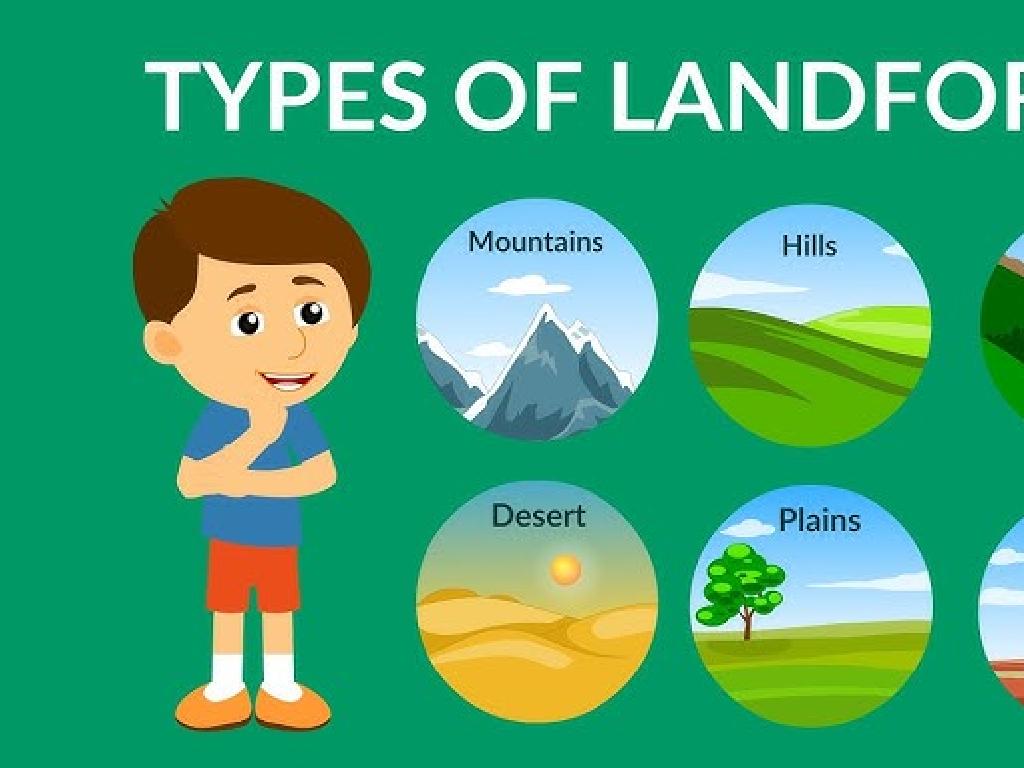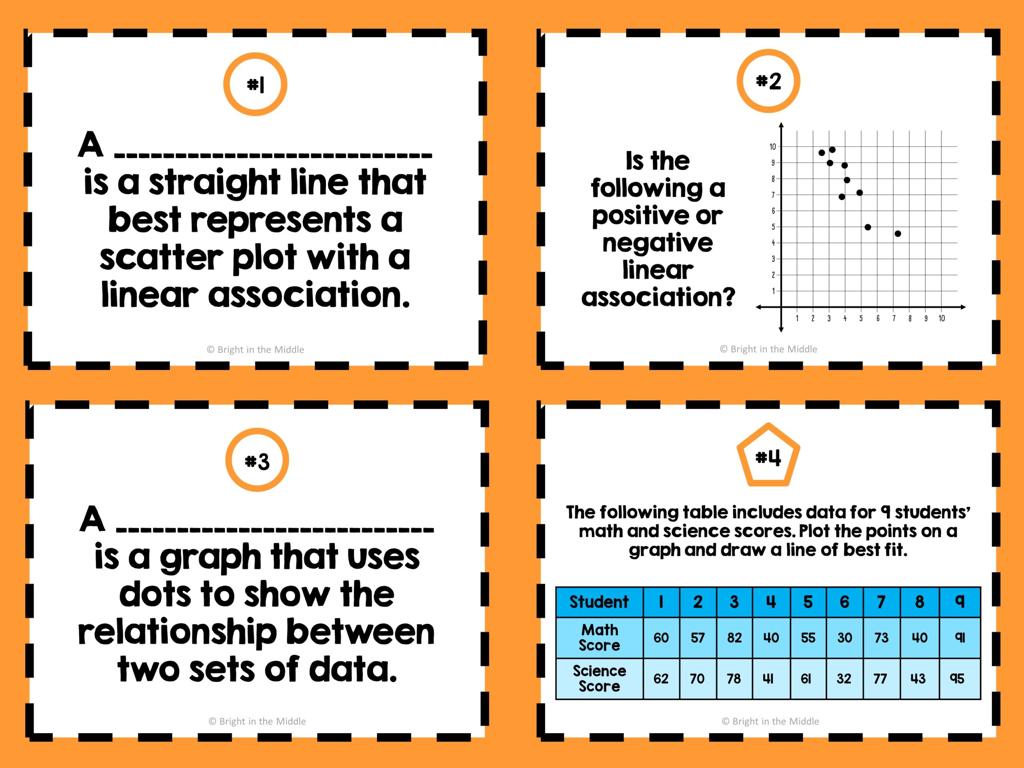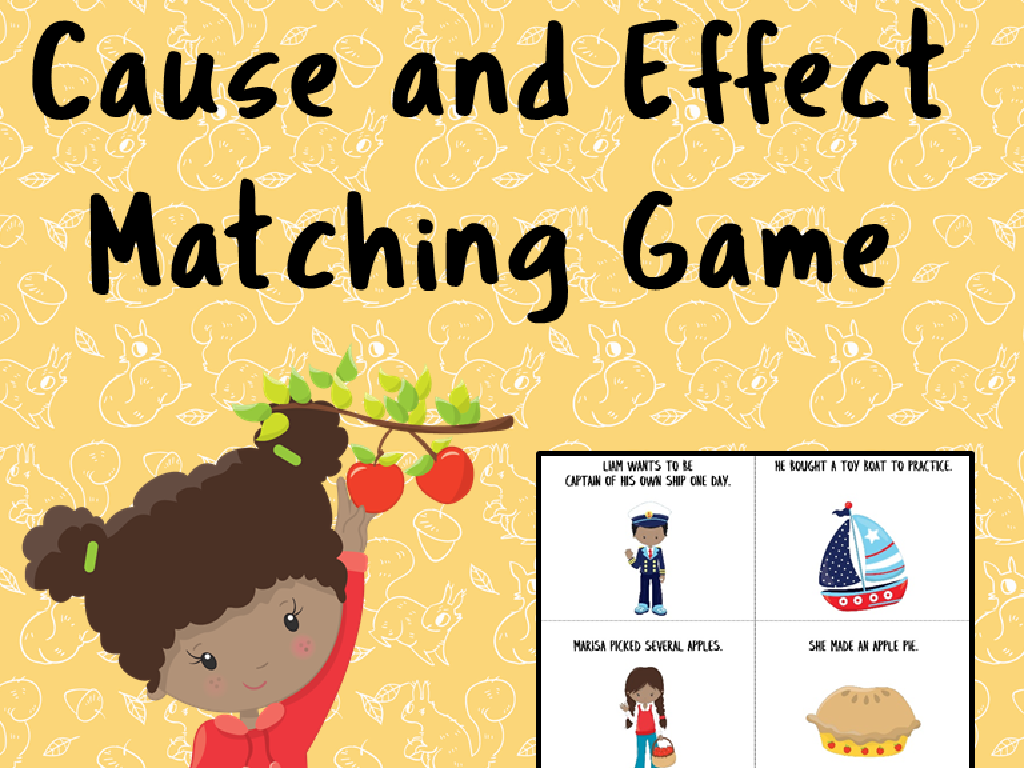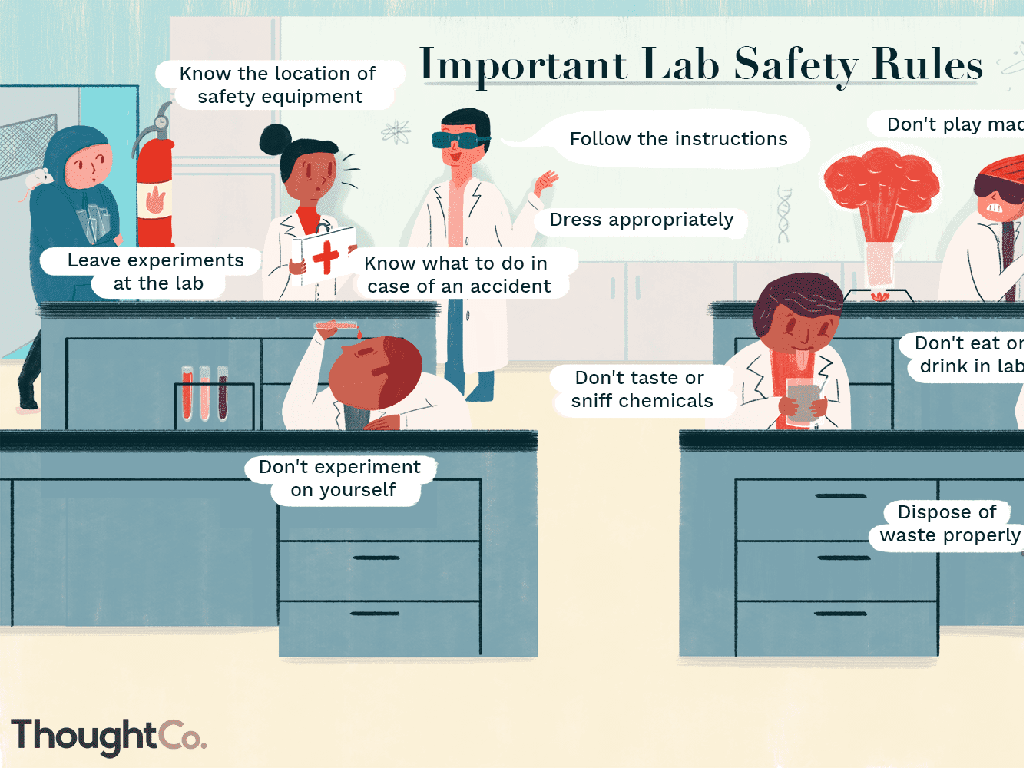Match Each Effect To Its Cause
Subject: Language arts
Grade: Second grade
Topic: Cause And Effect
Please LOG IN to download the presentation. Access is available to registered users only.
View More Content
Welcome to Cause and Effect!
– Understanding cause & effect
– Defining cause and effect
– Cause is why something happens; effect is what happens
– Everyday life examples
– Like when it rains (cause) and we use umbrellas (effect)
– Activity: Matching game
– We’ll match reasons (causes) to things that happen (effects)
|
This slide introduces the concept of cause and effect to second-grade students. Begin by explaining that understanding cause and effect helps us know why things happen. Define ’cause’ as the reason something happens and ‘effect’ as what happens as a result. Use relatable examples such as weather events or daily routines to illustrate the concept. For the activity, prepare a matching game with cards that have causes on one set and effects on another, and ask students to find the correct pairs. This interactive approach will help solidify their understanding of the relationship between causes and effects.
Understanding Cause and Effect
– What is a Cause?
– It’s the reason why an event occurs
– Causes make things happen
– Like a starting point for an action
– Example: Domino effect
– Knocking over the first domino causes the rest to fall
– Recognizing causes in stories
– Find what makes events happen in a story
|
This slide introduces the concept of ’cause’ in the context of cause and effect relationships. A cause is an initiating event that leads to an effect, or an outcome. Use the domino effect as a tangible example to illustrate how one action can lead to another. This will help students understand that in stories, just like in real life, there are reasons why things happen (causes), and there are things that happen as a result (effects). Encourage students to think of simple examples from their daily lives where one event causes another, and discuss how identifying these relationships can help with reading comprehension.
Understanding Effects in Cause and Effect
– What is an effect?
– It’s what happens because of a cause
– Effects are outcomes or results
– Think of it like the end of a story
– Example: Eating ice cream
– Cause: Eating ice cream. Effect: Feeling happy or cold
– How feelings can be effects
– Feelings happen because of something else
|
This slide is aimed at helping second-grade students understand the concept of ‘effect’ in the context of cause and effect relationships. Begin by explaining that an effect is what happens as a result of a specific action or cause. It’s like the conclusion of a story that started with the cause. Use relatable examples, such as eating ice cream, to illustrate how an action can lead to a feeling or result, which is the effect. Encourage students to think of other examples from their experiences where they can identify the cause and the resulting effect. This will help them grasp the concept of cause and effect in everyday situations.
Matching Game: Causes and Effects
– Play a cause and effect game
– Observe pictures and sentences
– Determine the cause
– Why did something happen in the story?
– Discuss the effect
– What happened as a result?
|
This interactive game is designed to help second-grade students understand the concept of cause and effect in a fun and engaging way. Provide students with a series of pictures and sentences that illustrate simple cause-and-effect relationships. Encourage them to think critically about why something happened (the cause) and what happened as a result (the effect). Facilitate a discussion where students can share their thoughts and reasoning with the class. This activity will not only reinforce their comprehension skills but also promote speaking and listening skills as they articulate their ideas and listen to others.
Matching Effects to Causes
– Understanding cause and effect
– If it rains, what happens?
– The street gets wet or puddles form
– Forget your umbrella, then what?
– You might get wet and feel unhappy
– Discussing cause and effect
|
This slide is aimed at helping second-grade students understand the concept of cause and effect through relatable examples. Begin by explaining that a ’cause’ is why something happens, and an ‘effect’ is what happens as a result. Use the example of rain causing the street to get wet to illustrate this relationship. Then, ask students how they would feel if they forgot their umbrella on a rainy day, guiding them to connect their feelings as the effect of the cause (forgetting the umbrella). Encourage students to think of other cause-and-effect scenarios in their daily lives and be ready to discuss these in class. This will help them grasp the concept more concretely.
Your Turn: Matching Cause and Effect
– Match effects to their causes
– Work with a partner
– Choose a classmate to team up with
– Find pairs that make sense
– Discuss and decide what caused each effect
– Share your matches with the class
– Be prepared to explain your choices
|
This slide is designed to engage students in a collaborative activity where they apply their understanding of cause and effect. Students should work in pairs to match a list of effects with their corresponding causes. Provide them with examples or a worksheet with mixed causes and effects. Encourage them to discuss each match and come to a consensus with their partner. After the activity, ask each pair to share their matches and explain their reasoning to the class. This will help reinforce their comprehension and allow for peer learning. As a teacher, be ready to facilitate and guide the students through the activity, ensuring that each pair understands the concept and participates actively.
Review and Share: Understanding Cause & Effect
– Review our cause and effect matches
– Discuss reasons for our matches
– Share why you think your match is right
– Comprehend cause and effect in stories
– How cause and effect shapes narratives
– Apply cause and effect to the world
– Recognize cause and effect in daily life
|
This slide is meant to facilitate a class discussion on the cause and effect matches that the students have made. Start by having a few students share their matches and explain their reasoning. Emphasize the importance of understanding cause and effect as a critical reading comprehension skill that helps in identifying the relationship between events in stories. Also, discuss how this concept applies to real-world situations and can help us make sense of events that happen around us. Encourage students to think of examples from their own experiences where they observed a cause leading to an effect. This will help solidify their understanding and show the practical application of the concept.
Class Activity: Cause and Effect Chain
– Collaborate on a paper chain
– Each link is a cause or effect
– Build the longest chain possible
– Understand cause and effect
– Learn how events are connected
|
This activity is designed to help students visually and tangibly understand the concept of cause and effect. Each student will be given strips of paper to write down a cause or an effect. They will then link their paper strips with those of their classmates to form a chain. The goal is to create a long paper chain that represents a series of causes and effects. Teachers should guide students to think of simple everyday events that have clear causes and effects to write on their strips. Possible activities could include: ‘I kicked the ball (cause) and it flew over the fence (effect),’ or ‘It rained (cause) so the flowers grew (effect).’ This will help students see the direct relationship between actions and outcomes in a fun and interactive way.






